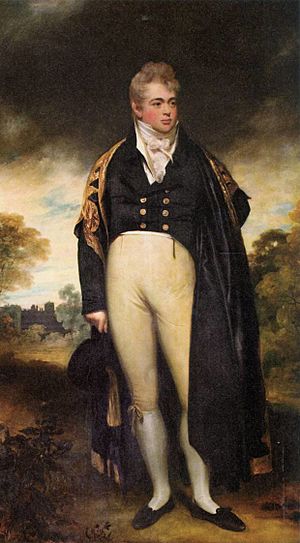Howe Browne, 2nd Marquess of Sligo facts for kids
Quick facts for kids
Howe Peter Browne
|
|
|---|---|
 |
|
| Governor of Jamaica | |
| In office 1834–1836 |
|
| Lord Lieutenant of Mayo | |
| In office 1831–1845 |
|
| Marquess of Sligo | |
| In office 1809–1845 |
|
| Preceded by | John Browne |
| Succeeded by | George Browne |
| Personal details | |
| Born | 18 May 1788 London, England |
| Died | 26 January 1845 (aged 56) Royal Tunbridge Wells, Kent, England |
| Resting place | Kensal Green Cemetery, London, England |
| Spouse | Hester Catherine de Burgh |
| Children | 14, including George |
| Parents |
|
| Alma mater | Eton College Jesus College, Cambridge |
Howe Peter Browne, the 2nd Marquess of Sligo, was an important figure in British and Irish history. He was born in London, England, on May 18, 1788. He later became a colonial governor, which meant he was in charge of a British territory far from home. He is best known for his work to end slavery in Jamaica. He passed away on January 26, 1845, in Tunbridge Wells, England.
Contents
Early Life and Education
Howe Browne was the son of John Browne, who was the 1st Marquess of Sligo. He went to school at Eton College, a famous boarding school. After that, he studied at Jesus College, Cambridge University, where he earned his Master's degree in 1808. When his father passed away in 1809, Howe became the 2nd Marquess of Sligo. He was also made a Knight of the Order of St Patrick, which is a special honor.
Family Life
On March 4, 1816, Howe Browne married Hester Catherine. She was 16 years old at the time. Together, they had 14 children between 1817 and 1839. Their children included George, who later became the 3rd Marquess of Sligo.
Lady Hester was a very cultured woman. She supported artists and helped improve Westport House, which was the family's main home in Ireland. She also worked on its beautiful gardens. The family also had a home in London. Both Lord and Lady Sligo strongly believed in ending slavery. They also worked to help people during the Irish famine, a time when many people did not have enough food. Lady Hester also supported the Sisters of Mercy, a group of nuns who help others.
Governor of Jamaica and Anti-Slavery Efforts
In 1834, Howe Browne was chosen to be the Governor of Jamaica. This was a very important job. When he arrived, many people who owned large farms (plantations) in Jamaica thought he would support them. This was because his family also owned some land there. However, Howe Browne did not agree with slavery, which was still practiced on the island.
He arrived in Jamaica shortly after the Slavery Abolition Act 1833 was passed. This law aimed to end slavery. Howe Browne worked hard to help Jamaica change from a society with slavery to a free one. He made changes to the legal system. He also helped set up schools for the Black population. He even paid for two of these schools himself.
Because of his actions, many powerful plantation owners in Jamaica did not like him. They tried to stop his efforts to free the Black Jamaican people. In 1836, they managed to force him to leave his position as Governor. Even though he faced challenges, his work was remembered. The first free village in Jamaica, called Sligoville, is named after him. It is located in Saint Catherine Parish.
Lord and Lady Sligo are buried together in Kensal Green Cemetery in London.
Images for kids




